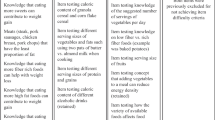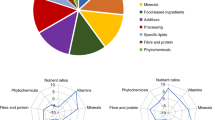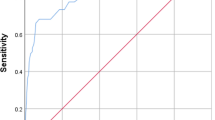Abstract
Background:
Food labels may have an important function in communicating nutrition information and have considerable potential to influence food choice and dietary behaviour.
Objectives:
To assess the validity and reliability of a short (self-complete) questionnaire designed to measure consumers’ use and understanding of food labels.
Methods:
Questionnaire content was determined by gaps highlighted in a literature review of food labelling. Nineteen questions (49 items) assessing frequency of label reading perceived importance of food labels, regularity of dining out, desire to have nutrition information at specific catering outlets and ability to perform nutrition information tasks were formulated and presented on four pages of A4. With the exception of two open-ended questions, all items were presented as closed (field box) structures. Content validity, face validity, item analysis, repeat and internal reliability were assessed.
Results:
Nutrition experts (26) completed detailed content validity assessment, resulting in high scores for appropriateness, importance and phrasing of questions, although grammar and terminology changes were required. Face validity indicated that the questionnaire was quick to complete (<15 min), easy to follow and comprehensible. Cronbach's alpha scores (internal reliability) for questions with multiple sections ranged from 0.72 to 0.91, indicating good internal consistency. Repeat reliability testing showed Spearman's correlation coefficients ranging from 0.51 to 0.97 (all P<0.001) showing high temporal stability. Item Difficulty analysis indicated that questions (Section C only) were at an appropriate level (with P between 20 and 80% for all items). Item discrimination analysis ranged from r=0.43 to 0.70, highlighting that items were suitable for inclusion.
Conclusions:
This questionnaire is a suitable tool for assessing consumers’ use, understanding and perception of food labels.
This is a preview of subscription content, access via your institution
Access options
Subscribe to this journal
Receive 12 print issues and online access
$259.00 per year
only $21.58 per issue
Buy this article
- Purchase on Springer Link
- Instant access to full article PDF
Prices may be subject to local taxes which are calculated during checkout
Similar content being viewed by others
References
Black A, Rayner M (1992). Just Read the Label. The Coronary Prevention Group: London.
Bland MJ, Altman DG (1997). Cronbach's Alpha. BMJ 314, 572–573.
Council Directive 90/496/EEC of 24 September on nutrition labelling for foodstuffs (1990). Council Directive 90/496/EEC of 24 September on nutrition labelling for foodstuffs.
Council Directive 2000/13/EC of the European Parliament and of the Council of 20 March 2000 (2000). Council Directive 2000/13/EC of the European Parliament and of the Council of 20 March 2000. 2000/13/EC.
Cowburn G, Stockley L (2005). Consumer understanding and use of nutrition labelling: a systematic review. Public Health Nutr 8, 21–28.
Defra (2006). Family Food in 2004–2005. National Statistics: London.
DeVon HA, Block ME, Moyle-Wright P, Ernst DM, Hayden SJ, Lazzara DJ et al. (2007). A psychometric toolbox for testing validity and reliability. J Nurs Sch Second Quarter 39, 155–164.
Edwards P, Roberts I, Clarke M, DiGuiseppi C, Pratap S, Wentz R et al. (2002). Increasing response rates to postal questionnaires: systematic review. BMJ 324, 1183.
EU (2008). Proposal for a Regulation of the European Parliament and of the Council on the Provision of Food Information to Consumers. Official Journal of the European Union: Brussels
European Heart Network (2003). A systematic review of the research on consumer understanding of nutrition labelling. European Heart Network: Brussels.
Flesch R (1948). A new readability yardstick. J Appl Psychol 32, 221–233.
Food Standards Agency (2006). Consumer Attitudes to Food Standards 2005. Food Standards Agency: London.
Food Standards Agency (2007). Consumer Attitudes to Food Standards. Food Standards Agency: London.
Grunert KG, Wills JM (2007). A review of European research on consumer response to nutrition information on food labels. J Public Health 15, 385–399.
Hawkes C (2004). Nutrition Labels and Health Claims: The Global Regulatory Environment. World Health Organisation: Geneva.
Higginson CS, Rayner MJ, Draper S, Kirk TR (2002). The nutrition label—which information is looked at? Nutr Food Sci 32, 92–99.
Institute of Grocery Distribution (1998). Voluntary Nutrition Labelling Guidelines to Benefit the Consumer. IGD.
Jepson C, Asch DA, Hershey JC, Ubel PA (2005). In a mailed physician survey, questionnaire length had a threshold effect on response rate. J Clin Epidemiol 58, 103–105.
Kessler H, Wunderlich SM (1999). Relationship between use of food labels and nutrition knowledge of people with diabetes. Diabetes Educ 25, 549–559.
Kline P (1986). A Handbook of Test Construction. Introduction to Psychometric Design. Methuen & Co Ltd: London.
Kline P (1993). The Handbook of Psychological Testing. Routledge: London.
Krukowski RA, Harvey-Berino J, Kolodinsky J, Narsana RT, Desisto TP (2006). Consumers may not use or understand calorie labeling in restaurants. J Am Diet Assoc 106, 917–920.
Levy AS, Fein SB (1998). Consumers’ ability to perform tasks using nutrition labels. J Nutr Educ 30, 210–217.
Mannell A, Brevard P, Nayga RM, Combris P, Lee R, Gloeckner J (2006). French consumers’ use of nutrition labels. Nutr Food Sci 36, 159–168.
Marietta AB, Welshimer KJ, Anderson SL (1999). Knowledge, attitudes, and behaviors of college students regarding the 1990 Nutrition Labeling Education Act food labels. J Am Diet Assoc 99, 445–449.
McColl E, Jacoby A, Thomas L, Soutter J, Bamford C, Steen N et al. (2001). Design and use of questionnaires: a review of best practice applicable to surveys of health service staff and patients. Health Technol Assess 5, 1–256.
Microsoft (2007). Frequently asked questions about grammar proofing in Word. Microsoft Corporation.
Mintel (2007). Eating Out Review—Leisure Intelligence. Mintel International Group Limited: London.
National Institute of Nutrition (1999). Nutrition labeling: perceptions and preferences of Canadians. Ottawa.
Neuhouser ML, Kristal AR, Patterson RE (1999). Use of food nutrition labels is associated with lower fat intake. J Am Diet Assoc 99, 45–53.
New York City Department of Health and Mental Hygiene (2007). New York City Health Code (Repeal and reenact 81.50).
Rattray J, Jones MC (2007). Essential elements of questionnaire design and development. J Clin Nurs 16, 234–243.
Rothman RL, Housam R, Weiss H, Davis D, Gregory R, Gebretsadik T et al. (2006). Patient understanding of food labels the role of literacy and numeracy. Am J Prev Med 31, 391–398.
Stuart SA, Schroder M, Hughes A, Bower J (2004). Dimensional analysis of schoolchildren's food label comprehension: a pilot study. Int J Cons Stud 28, 135–146.
Sudman S, Bradburn N (1982). Asking Questions. A Practical Guide to Questionnaire Design. Jossey-Bass Inc.: California.
Acknowledgements
This research was funded by the Food Standards Agency Postgraduate Scholarship Scheme. We thank Dawn Mackison, Tommy Mackison and the staff at the Centre for Public Health Nutrition Research for their help with the packaging and dissemination of the questionnaire.
Author information
Authors and Affiliations
Corresponding author
Appendix Table 1
Appendix Table 1
Rights and permissions
About this article
Cite this article
Mackison, D., Wrieden, W. & Anderson, A. Validity and reliability testing of a short questionnaire developed to assess consumers’ use, understanding and perception of food labels. Eur J Clin Nutr 64, 210–217 (2010). https://doi.org/10.1038/ejcn.2009.126
Received:
Revised:
Accepted:
Published:
Issue Date:
DOI: https://doi.org/10.1038/ejcn.2009.126



